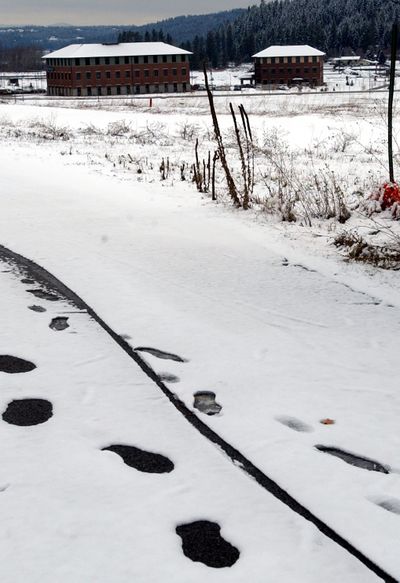Heart of trail marches onward
Many resources are behind the maintenance and expansion of region’s jewel Centennial Trail

If you use North Idaho’s Centennial Trail, you have a stake in its future, according to Charlie Miller, manager of the foundation that oversees its use and development under a 16-member volunteer board.
Miller is a 28-year-old Coeur d’Alene native who’s been in charge for the past year. Once a cross-country runner for Lake City High, North Idaho College and the University of Idaho from which he graduated with a natural resource recreation degree, he obviously has appropriate credentials for his job. He also projects an infectious enthusiasm for the trail.
His association with the trail began in 1990 when his Cub Scout pack planted trees along the trail. As he grew, he ran and biked its length.
The 23 miles that meander from Higgens Point, 6 miles east of Coeur d’Alene, to the Idaho/Washington state line is part of the 60-mile interstate Centennial Trail which ends west of Spokane.
According to Miller, its genesis was in 1907 when Frederick Law Olmstead, the famed landscape architect who designed New York’s Central Park, was contracted by the city of Spokane to lay out its park system. As part of his master plan, he suggested a scenic trail that would follow the Spokane River.
That part of Olmstead’s vision lay dormant for 82 years until, in 1989, Washington began developing its portion of the trail in celebration of the state’s centennial. Idaho followed suit the following year, for its centennial, and the first 4 1/2 miles of the Idaho portion of the trail were paved that year.
If you’re new to the area, here’s a quick brief: Both the Idaho and Washington portions are open to skaters, walkers, runners and bicyclists; motorized vehicles and horses aren’t allowed. The entire interstate trail has been paved and you’ll find restrooms, water fountains, benches, mile markers and interpretive signs at convenient intervals.
But even if you’ve been around awhile, you might not know that it’s plowed during our winter months, enabling year-round use.
The Idaho trail is under four jurisdictions, each of which owns land under the trail and is responsible for maintenance of that portion. Those are the Kootenai County Parks and Waterways Department, and the Parks and Recreation Departments for Post Falls, Coeur d’Alene and the state of Idaho.
Because of the heavy snow earlier this year, the Forest Steel Co. volunteered to plow the trail from the Beach House to Higgens Point.
Other maintenance includes applying a slurry coat to the asphalt every five to 10 years to keep moisture from penetrating. That costs $100,000, according to Miller, and it’s paid for by the agencies with supplemental funding provided by his organization, the nonprofit North Idaho Centennial Trail Foundation.
Within the past year, the foundation has acquired and paved a 4.25-mile addition to the Centennial Trail. Called the Prairie Trail, it’s a former railroad right-of-way abandoned by the Union Pacific and thus far stretches from the Riverstone complex to Huetter Road, passing through eight neighborhoods and by six schools.
Miller said that if funds are available, the foundation would like to extend the paving to Meyer Road within the next two years. That would cost about $200,000, he said.
Within Idaho, 90 percent of the trail is classified as Class 1; that is, it’s paved, separated from other roadways, dedicated to nonmotorized use and is at least 10 feet wide. Another 9 percent is Class 2, a designated and marked lane on a road, and 1 percent is simply a designated route.
One area of concern is in Post Falls, from Greens Ferry Road to Ross Point Road. It’s Class 2, and because it crosses the busy intersection at Highway 41 and Seltice Way and requires a detour, the foundation hopes to straighten it by acquiring a portion of right-of-way owned by the Burlington Northern Santa Fe Railroad when it’s abandoned by that firm.
In the meantime, it intends to improve the signals at that intersection and apply supplemental paint to the pavement.
A long-term goal, he said, is to push the trail east to Rose Lake where it would join the Trail of the Coeur d’Alenes, a 72-mile paved path from Mullan to Plummer.
The organization’s budget is $146,000 per year, and that doesn’t include any federal dollars. Its principal fundraiser is the entrance and sponsorship fees for the Coeur d’Alene Marathon that’s run each Memorial Day weekend.
There are many ways citizens can help: Join up, for one. Miller notes the trail is used 300,000 to 400,000 times each year, but fewer than 100 persons belong to the foundation. Individual memberships are $35, family memberships are $50 and patrons can belong for $100.
He said the foundation needs funds to pay for supplemental maintenance, his position and new facilities such as benches, restrooms and signage for the Prairies Trail.
Here are some other ways to get involved:
Foundation goals include increasing awareness of the trail, recruiting sponsors for events such as the litter pickup day in April and a ride/walk trail day, planning for additional trail development, recruiting additional volunteers for the annual marathon, helping a maintenance committee that sets policies, forming an outreach committee that would perform tasks such as educating kids and sponsoring bike rodeos, and publishing an e-mail newsletter.